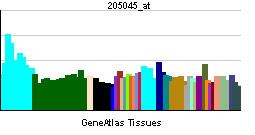Entrez 11216 | Ensembl ENSG00000108599 | |
 | ||
Aliases AKAP10, AKAP-10, D-AKAP-2, D-AKAP2, PRKA10, A-kinase anchoring protein 10 External IDs MGI: 1890218 HomoloGene: 32452 GeneCards: AKAP10 | ||
A kinase anchor protein 10, mitochondrial is an enzyme that in humans is encoded by the AKAP10 gene.
Contents
Function
The A-kinase anchor proteins (AKAPs) are a group of structurally diverse proteins, which have the common function of binding to the regulatory subunit of protein kinase A (PKA) and confining the holoenzyme to discrete locations within the cell. This gene encodes a member of the AKAP family. The encoded protein interacts with both the type I and type II regulatory subunits of PKA; therefore, it is a dual-specific AKAP. This protein is highly enriched in mitochondria. It contains RGS (regulator of G protein signalling) domains, in addition to a PKA-RII subunit-binding domain. The mitochondrial localization and the presence of RGS domains may have important implications for the function of this protein in PKA and G protein signal transduction.
